A Snakebite is an injury caused by the bite of a snake.
Snakebite or snake bite may also refer to:
A Snakebite is an injury caused by the bite of a snake.
Snakebite or snake bite may also refer to:
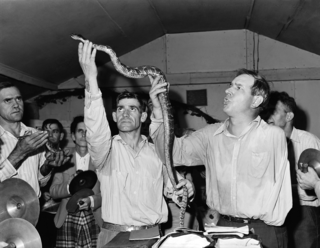
Snake handling, also called serpent handling, is a religious rite observed in a small number of isolated churches, mostly in the United States, usually characterized as rural and part of the Holiness movement. The practice began in the early 20th century in Appalachia and plays only a small part in the church service. Participants are Holiness, Pentecostals, Charismatics, or other evangelicals. The beliefs and practices of the movement have been documented in several films and have been the impetus for a number of state laws related to the handling of venomous animals.

Antivenom, also known as antivenin, venom antiserum, and antivenom immunoglobulin, is a specific treatment for envenomation. It is composed of antibodies and used to treat certain venomous bites and stings. Antivenoms are recommended only if there is significant toxicity or a high risk of toxicity. The specific antivenom needed depends on the species involved. It is given by injection.

A snakebite is an injury caused by the bite of a snake, especially a venomous snake. A common sign of a bite from a venomous snake is the presence of two puncture wounds from the animal's fangs. Sometimes venom injection from the bite may occur. This may result in redness, swelling, and severe pain at the area, which may take up to an hour to appear. Vomiting, blurred vision, tingling of the limbs, and sweating may result. Most bites are on the hands, arms, or legs. Fear following a bite is common with symptoms of a racing heart and feeling faint. The venom may cause bleeding, kidney failure, a severe allergic reaction, tissue death around the bite, or breathing problems. Bites may result in the loss of a limb or other chronic problems or even death.
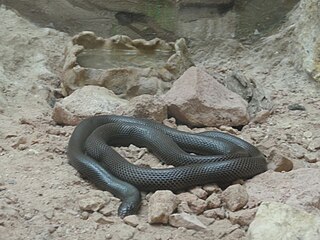
The Atractaspididae are a family of venomous snakes found in Africa and the Middle East, commonly called mole vipers, stiletto snakes, or burrowing asps. Currently, 12 genera are recognized.
Envenomation is the process by which venom is injected by the bite or sting of a venomous animal.

Snake Bite Love is the fourteenth studio album by British rock band Motörhead. It was released on 10 March 1998 via Steamhammer, their third with the label.
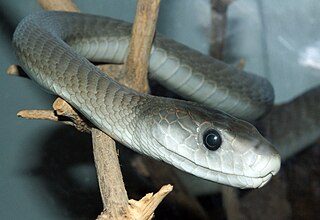
The black mamba is a species of highly venomous snake belonging to the family Elapidae. It is native to parts of sub-Saharan Africa. First formally described by Albert Günther in 1864, it is the second-longest venomous snake after the king cobra; mature specimens generally exceed 2 m and commonly grow to 3 m. Specimens of 4.3 to 4.5 m have been reported. Its skin colour varies from grey to dark brown. Juvenile black mambas tend to be paler than adults and darken with age.
A snake-stone, also known as a viper's stone, snake's pearl, black stone, serpent-stone, or nagamani is an animal bone or stone used as folk medicine for snake bite in Africa, South America, India and Asia.

The four venomous snake species responsible for causing the greatest number of medically significant human snake bite cases on the Indian subcontinent are sometimes collectively referred to as the Big Four. They are as follows:
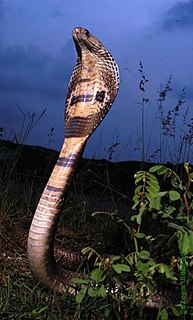
The Indian cobra, also known as the spectacled cobra, Asian cobra, or binocellate cobra, is a species of Cobra found, in India, Pakistan, Bangladesh, Sri Lanka, Nepal, and Bhutan, and a member of the "big four" species that are responsible for the most snakebite cases in India. It is distinct from the king cobra which belongs to the monotypic genus Ophiophagus. The Indian cobra is revered in Hindu mythology and culture, and is often seen with snake charmers. It is a protected species under the Indian Wildlife Protection Act (1972).
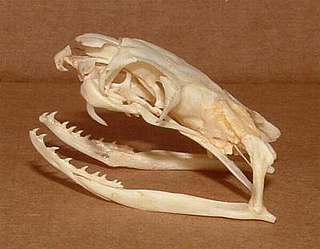
Venomous snakes are species of the suborder Serpentes that are capable of producing venom, which they use for killing prey, for defense, and to assist with digestion of their prey. The venom is typically delivered by injection using hollow or grooved fangs, although some venomous snakes lack well-developed fangs. Common venomous snakes include the families Elapidae, Viperidae, Atractaspididae, and some of the Colubridae. The toxicity of venom is mainly indicated by murine LD50, while multiple factors are considered to judge the potential danger to humans. Other important factors for risk assessment include the likelihood that a snake will bite, the quantity of venom delivered with the bite, the efficiency of the delivery mechanism, and the location of a bite on the body of the victim. Snake venom may have both neurotoxic and hemotoxic properties.

A Monroe piercing is a lip piercing placed off-center, above the upper lip on the left-hand side and is meant to resemble Marilyn Monroe's beauty spot, although Monroe's beauty spot was on her cheek, not her lip. The Madonna piercing is similar but worn on the right-hand side.

The Brooklyn Papyrus is a medical papyrus dating from ancient Egypt and is one of the oldest preserved writings about medicine and ophiology. The manuscript is dated to around 450 BCE and is today kept at the Brooklyn Museum in New York.
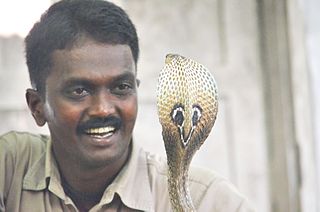
Vava Suresh is an Indian wildlife conservationist and a snake expert. He is known for his mission of saving snakes that have strayed into human-inhabited areas in Kerala, India. He has captured 200 King cobras, and is believed to have captured and rescued more than 38,000 straying snakes.

The coastal taipan, or common taipan, is a species of highly venomous snake in the family Elapidae. Described by Wilhelm Peters in 1867, the species is native to the coastal regions of northern and eastern Australia and the island of New Guinea. The second-longest venomous snake in Australia, the coastal taipan averages around 2 m (6.6 ft) long, with the longest specimens reaching 2.9 m (9.5 ft) in length. It has light olive or reddish-brown upperparts, with paler underparts. The snake is considered to be a least-concern species according to the International Union for Conservation of Nature.
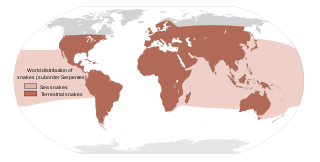
Most snakebites are caused by non-venomous snakes. Of the roughly 3,700 known species of snake found worldwide, only 15% are considered dangerous to humans. Snakes are found on every continent except Antarctica. There are two major families of venomous snakes, Elapidae and Viperidae. Three hundred twenty five species in 61 genera are recognized in the family Elapidae and 224 species in 22 genera are recognized in the family Viperidae, In addition, the most diverse and widely distributed snake family, the colubrids, has approximately 700 venomous species, but only five genera—boomslangs, twig snakes, keelback snakes, green snakes, and slender snakes—have caused human fatalities.